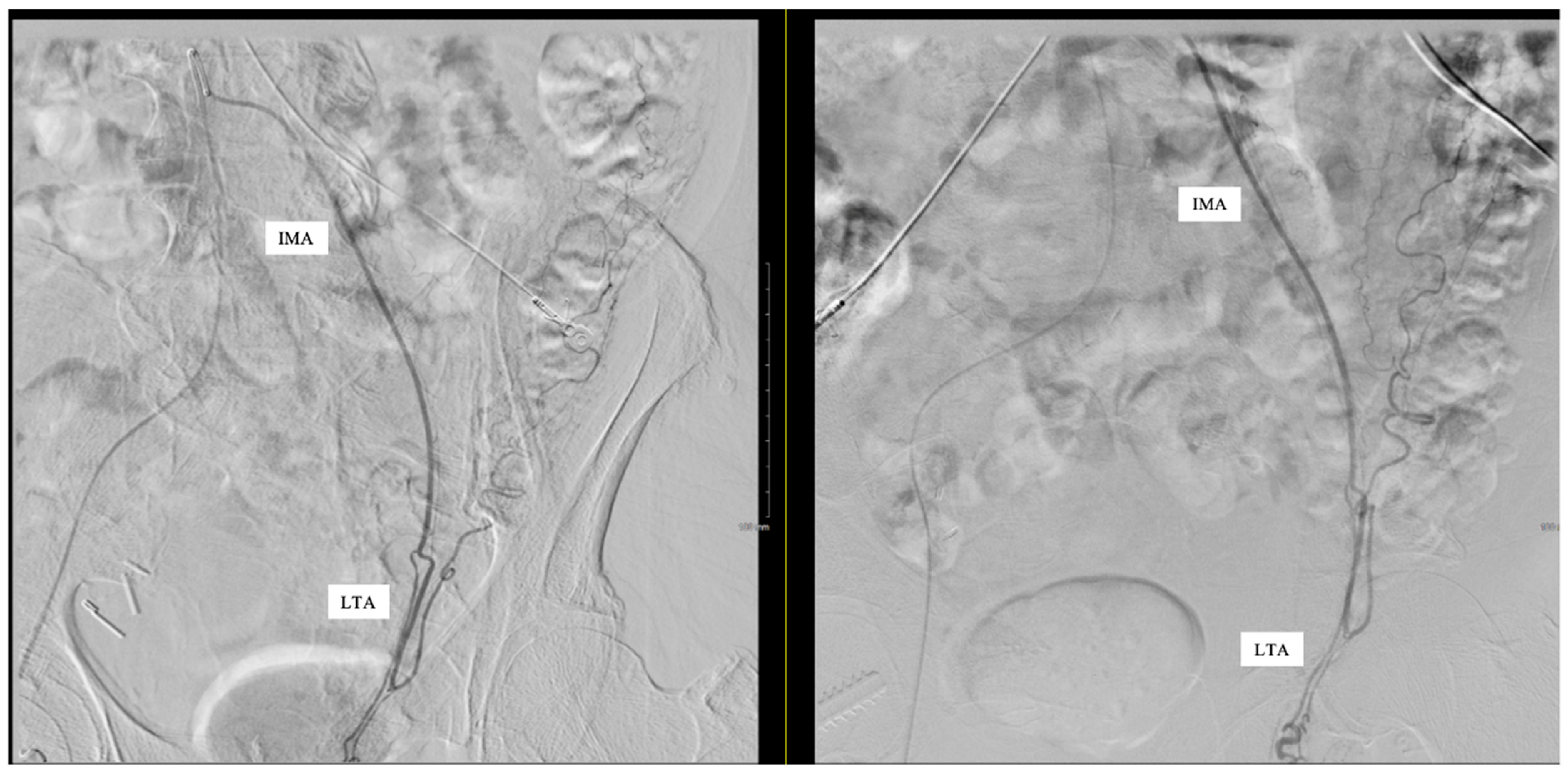Aberrant Left Testicular Artery Originating from the Inferior Mesenteric Artery Identified on Angiography in a Patient with Gastrointestinal Bleeding: Case Report
Abstract
1. Introduction and Clinical Significance
2. Case Presentation
3. Discussion
4. Conclusions
Author Contributions
Funding
Institutional Review Board Statement
Informed Consent Statement
Data Availability Statement
Conflicts of Interest
Abbreviations
| LTA | Left Testicular Artery |
| IMA | Inferior Mesenteric Artery |
| SRA | Superior Rectal Artery |
| GIB | Gastrointestinal Bleed |
| CTA | Computed Tomography Angiography |
| LCA | Left Colic Artery |
References
- Nallikuzhy, T.J.; Rajasekhar, S.S.S.N.; Malik, S.; Tamgire, D.W.; Johnson, P.; Aravindhan, K. Variations of the testicular artery and vein: A meta-analysis with proposed classification. Clin. Anat. 2018, 31, 854–869. [Google Scholar] [CrossRef] [PubMed]
- Niklas, N.; Malec, M.; Gutowski, P.; Kazimierczak, A.; Rynio, P. Effectiveness of Inferior Mesenteric Artery Embolization on Type II Endoleak-Related Complications after Endovascular Aortic Repair (EVAR): Systematic Review and Meta-Analysis. J. Clin. Med. 2022, 11, 5491. [Google Scholar] [CrossRef]
- Zhang, T.R.; Thorogood, S.L.; Miyauchi, J.; Del Pizzo, J.; Schlegel, P.N. Acute testicular infarction in the setting of SARS-CoV-2 infection and diabetic vasculopathy. Urol. Case Rep. 2023, 47, 102342. [Google Scholar] [CrossRef]
- Balci, S.; Duzgun, S.A.; Arslan, S.; Balci, H.; Karcaaltincaba, M.; Karaosmanoglu, A.D. Anatomy of testicular artery: A proposal for a classification with MDCT angiography. Eur. J. Radiol. 2021, 142, 109885. [Google Scholar] [CrossRef] [PubMed]
- Çiçekcibaşi, A.E.; Salbacak, A.; Şeker, M.; Ziylan, T.; Büyükmumcu, M.; Uysal, I.I. The origin of gonadal arteries in human fetuses: Anatomical variations. Ann. Anat. Anat. Anz. 2002, 184, 275–279. [Google Scholar] [CrossRef] [PubMed]
- Kayalvizhi, I.; Narayan, R.K.; Kumar, P. Anatomical variations of testicular artery: A review. Folia Morphol. 2017, 76, 541–550. [Google Scholar] [CrossRef][Green Version]
- Messana, G.; Ambrosi, L.; Moramarco, L.P.; Cionfoli, N.; Maestri, M.; Quaretti, P. Testicular artery originating from the inferior mesenteric artery: An alert for interventionalists—A case report. Radiol. Case Rep. 2021, 16, 2710–2713. [Google Scholar] [CrossRef]
- Yi, S.-Q.; Li, J.; Terayama, H.; Naito, M.; Iimura, A.; Itoh, M. A rare case of inferior mesenteric artery arising from the superior mesenteric artery, with a review of the review of the literature. Surg. Radiol. Anat. 2008, 30, 159–165. [Google Scholar] [CrossRef] [PubMed]
- Ding, Y.; Zhao, B.; Niu, W.; Hu, X.; Li, C.; Liu, Z.; Yu, B. Assessing anatomical variations of the inferior mesenteric artery via three-dimensional CT angiography and laparoscopic colorectal surgery: A retrospective observational study. Sci. Rep. 2024, 14, 1–8. [Google Scholar] [CrossRef] [PubMed]
- Kotian, S.R.; Pandey, A.K.; Padmashali, S.; Jaison, J.; Kalthur, S.G. A cadaveric study of the testicular artery and its clinical significance. J. Vasc. Bras. 2016, 15, 280–286. [Google Scholar] [CrossRef] [PubMed][Green Version]
- Basiouny, K.E.B.E.; Ghazi, M.S.; Niazi, G.-E.M.; Allam, A.E. Anatomical variants in prostatic artery embolization in treatment of benign prostatic hyperplasia. Egypt. J. Radiol. Nucl. Med. 2022, 53, 120. [Google Scholar] [CrossRef]
- Sharbidre, K.G.; Aziz, M.U.; Mohd, Z. Review of Abdominal Vascular Variations: Imaging and Clinical Implications. RadioGraphics 2022, 42, E27–E28. [Google Scholar] [CrossRef] [PubMed]


Disclaimer/Publisher’s Note: The statements, opinions and data contained in all publications are solely those of the individual author(s) and contributor(s) and not of MDPI and/or the editor(s). MDPI and/or the editor(s) disclaim responsibility for any injury to people or property resulting from any ideas, methods, instructions or products referred to in the content. |
© 2025 by the authors. Licensee MDPI, Basel, Switzerland. This article is an open access article distributed under the terms and conditions of the Creative Commons Attribution (CC BY) license (https://creativecommons.org/licenses/by/4.0/).
Share and Cite
Taheri, S.M.; Centner, C.S.; Shalash, R.H.; Sulehria, T.; Ohene Baah, N. Aberrant Left Testicular Artery Originating from the Inferior Mesenteric Artery Identified on Angiography in a Patient with Gastrointestinal Bleeding: Case Report. Reports 2025, 8, 86. https://doi.org/10.3390/reports8020086
Taheri SM, Centner CS, Shalash RH, Sulehria T, Ohene Baah N. Aberrant Left Testicular Artery Originating from the Inferior Mesenteric Artery Identified on Angiography in a Patient with Gastrointestinal Bleeding: Case Report. Reports. 2025; 8(2):86. https://doi.org/10.3390/reports8020086
Chicago/Turabian StyleTaheri, Sarah M., Connor S. Centner, Rahim H. Shalash, Touqeer Sulehria, and Nana Ohene Baah. 2025. "Aberrant Left Testicular Artery Originating from the Inferior Mesenteric Artery Identified on Angiography in a Patient with Gastrointestinal Bleeding: Case Report" Reports 8, no. 2: 86. https://doi.org/10.3390/reports8020086
APA StyleTaheri, S. M., Centner, C. S., Shalash, R. H., Sulehria, T., & Ohene Baah, N. (2025). Aberrant Left Testicular Artery Originating from the Inferior Mesenteric Artery Identified on Angiography in a Patient with Gastrointestinal Bleeding: Case Report. Reports, 8(2), 86. https://doi.org/10.3390/reports8020086




